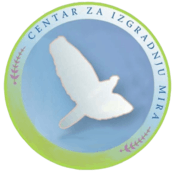Center for Peacebuilding
 | |
| Type | Non-profit organization |
|---|---|
| Location | |
Area served | Local, National, International |
| Website | www.unvocim.net/ |
Center for Peacebuilding (Centar za Izgradnju Mira, CIM) is a non-governmental organization based in Sanski Most, Una-Sana Canton, Bosnia-Herzegovina. The organization was founded in 2004 to address the ethnic divisions present in Bosnia-Herzegovina.
History and background
While the Dayton Agreement managed to put an end to the Bosnian war and the violence, it froze ethnic divisions.[1] Nationalistic discourse and hate speech are highly practised by political and religious leaders, and fuel hatred and acts of violence towards the "others".[2] Communities are segregated among ethnic and religious lines.[3] Negative stereotypes and prejudices are passed down to the new generations, which have few opportunities to interact with members of other ethnic groups, as they go to ethnically homogeneous schools.[4]
Projects and Activities
Since 2004, CIM has organized annual peace camps, where participants are offered the opportunity to engage in dialogue and openly discuss taboo topics related to the conflict. The camps bring together Bosnian individuals of mixed gender, ethnic and religious backgrounds, and train them to become peacebuilders. They learn skills in non-violent communication, active listening, prejudice reduction, and mediation. After peace camps, the participants are required to implement peacebuilding activities in their home communities. The aim of this project is to form a network of young peacebuilders across Bosnia and Herzegovina, who will become leaders, and help build a less segregated society for the new generations.[5]
Rates of violence in primary schools in BiH are very high. A USAID study suggested that 90% of primary school students are exposed to psychological violence, while 60% of them are exposed to physical violence.[6] Every year CIM organizes non-violent communication (NVC) workshops taught in primary schools in the local area. The topics CIM teaches in primary schools are: active listening, expressing emotions without fear, prejudices and stereotypes, addressing fears, and tolerance.
Apart from the NVC, CIM also organizes the Alternatives to Violence Project (AVP) three to four times a year. The AVP program is aimed towards local educators but is open to everybody within the community During the workshop CIM educators uses interactive exercises and role plays to encourage participants to examine how injustice, prejudice, frustration and anger can lead to violence.[7]
CIM organizes regular Interreligious dialogue meetings in Sanski Most between the leaders of the Christian Orthodox, Catholic, Protestant and the Muslim communities which is open to the public. In 2011 CIM organized an International Peace Week event, whose theme focused on interreligious dialogue.[8]
CIM's foreign language program is a popular incentive for the empowerment of youth . Starting with 2011, the center offers classes of English, French, German, Spanish, Turkish, Arabic, and Romanian.
The center also provides Craniosacral therapy for adults and youth who have been affected by war traumas.
International Cooperation
CIM hosts international delegations coming to Bosnia-Herzegovina to learn about the conflict and participate in peacebuilding. These delegations come from the United States, and Europe.[9]
In Nepal CIM helped a group of young people led by peacebuilder Phanindra Raj Kharel to establish the Center for Peacebuilding Nepal. CIM is currently in the process of establishing Centers in Australia and the USA.
Annually CIM receive two groups from the School for International Training, Vermont, United States who take part in a study visit in the local area.[10] CIM is part of their study abroad program. Through the program CIM hosts students and gives them opportunities for research.
Every year, CIM hosts a Global Youth Connect delegation. The International participants will interract with local youth and will participate in workshops on conflict transformation.[11]
In the spring of 2011, the organization hosted a group of students from Yale University and organized a short program about local non-governmental organizations in Sanski Most.[12]
In 2011 the director of CIM, Vahidin Omanovic, was the recipient of the 5th International Bremen Peace Award. He received the prize of Unknown Peace Worker.[13]
References
- ↑ Bilefsky, Dan (11 November 2008). "New York Times, 13 years after Dayton accord, ethnic divisions again threaten Bosnia". journalism. Retrieved 9 November 2011.
- ↑ Report by Thomas Hammarberg, Commissioner for Human Rights of the Council of Europe, following his visit to Bosnia and Herzegovina on 27–30 November 2010
- ↑ Baldwin, Clive (8 August 2006). "The Guardian, Europe's apartheid". journalism. London. Retrieved 9 November 2011.
- ↑ Traynor, Ian (18 November 2005). "The Guardian, A country with 14 governments where children refuse to cross ethnic divides". journalism. London. Retrieved 9 November 2011.
- ↑ "Center for Peacebuilding". peacebuilding. Retrieved 3 November 2011.
- ↑ USAID, “Prevention of Violence Involving Children and Promotion of Respect for Differences in BiH,”May 2010
- ↑ "Alternatives to Violence Project International". peacebuilding. Retrieved 9 November 2011.
- ↑ Begic, Aida. "International Peace Week in Sanski Most 2011". peacebuilding. Retrieved 3 November 2011.
- ↑ Branscome, Tyler. "Global Youth Connect Report Bosnia 2011" (PDF). peace and conflict. Retrieved 3 November 2011.
- ↑ "SIT Study abroad programs, Serbia, Bosnia and Kosovo". education. Retrieved 3 November 2011.
- ↑ "Global Youth Connect Bosnia". education. Retrieved 3 November 2011.
- ↑ http://dl.dropbox.com/u/7113413/231830.JPG, accessed 2011-05-13
- ↑ "International Bremen Peace Prize". peace. Retrieved 3 November 2011.